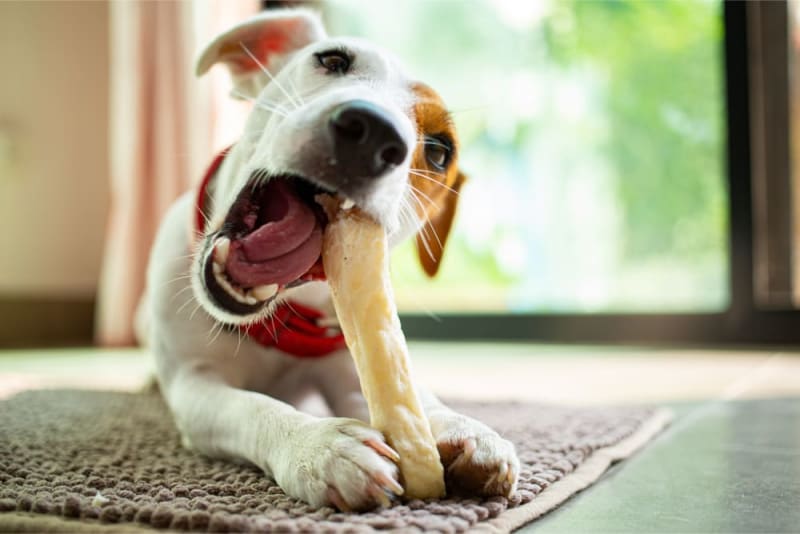Many dog owners find themselves wondering whether it's safe to give their furry companions ham bones as a treat. While dogs may be drawn to the scent and taste of these bones, it's critical to understand the potential risks involved. Here, we will explore whether dogs can have ham bones and discuss safer alternatives to ensure your dog's health and well-being.

Understanding the Risks of Feeding Ham Bones to Dogs
1. The Dangers of Cooked Bones
Cooked bones, including ham bones, can pose significant risks to dogs. When bones are cooked, they become more brittle and prone to splintering. These sharp splinters can cause severe damage to a dog's mouth, throat, or digestive system if ingested.
2. Splintering and Choking Hazards
Ham bones, like other cooked bones, tend to splinter when chewed. These sharp fragments can get lodged in a dog's throat, causing choking or even puncturing the esophagus. Additionally, if a bone splinters while being chewed, it can lead to serious internal injuries if swallowed.
3. Risk of Gastrointestinal Obstruction
Feeding ham bones to dogs can increase the risk of gastrointestinal obstruction. The bone fragments can get stuck in the dog's digestive tract, leading to blockages that may require surgical intervention. Symptoms of obstruction include vomiting, diarrhea, abdominal pain, and loss of appetite.
4. High Salt Content
Ham bones often contain a high amount of salt, which can be detrimental to a dog's health. Excessive salt intake can lead to dehydration, electrolyte imbalances, and salt poisoning. These conditions can cause symptoms such as increased thirst, vomiting, diarrhea, tremors, and even seizures.
Potential Health Risks of Feeding Dogs Ham Bones
Feeding dogs ham bones can pose several potential health risks. It is decisive to be aware of these risks to ensure the well-being and safety of your furry friend.

Bone-Related Injuries: Ham bones, especially cooked ones, can cause bone-related injuries in dogs. The bones may splinter and create sharp edges that can harm your dog's mouth, throat, or digestive system. Fractured teeth, cuts, and lacerations are common injuries that can result from chewing on ham bones.
Gastrointestinal Issues: When dogs chew on ham bones, there is a risk of gastrointestinal problems. The sharp fragments of the bone can damage the delicate lining of the digestive tract, leading to inflammation, bleeding, and discomfort. In severe cases, these fragments can cause blockages and require surgical intervention.
Salt Poisoning: Ham bones often contain a high amount of salt, which can be harmful to dogs. Excessive salt intake can lead to salt poisoning, causing symptoms such as increased thirst, vomiting, diarrhea, tremors, and even seizures. It is essential to monitor your dog's salt intake and avoid feeding them foods with high salt content like ham bones.
Pancreatitis: Feeding ham bones to dogs can increase the risk of pancreatitis. The rich and fatty nature of ham can trigger inflammation of the pancreas, which is responsible for digestion. Pancreatitis can cause severe abdominal pain, vomiting, diarrhea, and in severe cases, organ failure.
Bacterial Infections: Ham bones, especially if not handled or stored properly, can harbor harmful bacteria such as Salmonella or E. coli. These bacteria can cause gastrointestinal infections in dogs, leading to symptoms like vomiting, diarrhea, abdominal pain, and fever.
To ensure the health and safety of your beloved pet, it is advisable to avoid feeding them ham bones altogether. Instead, consider safer alternatives that provide similar chewing benefits without the associated risks.
Alternatives to Ham Bones
Instead of feeding ham bones to your dog, several safe and healthy alternatives can provide them with satisfying chewing experiences. Consider the following alternatives:
Safe Bone Options for Dogs: If you're looking for a bone-like treat for your dog, opt for safer alternatives such as raw bones specifically designed for chewing. Raw bones are less likely to splinter and pose fewer risks to your dog's health. However, it is prominent to choose the appropriate size and consult your veterinarian before introducing any new bones into your dog's diet.
Nutritious and Safe Treats: There are plenty of nutritious and safe treats available for dogs that offer similar chewing benefits as bones. Look for treats made from natural ingredients, such as dental sticks, jerky strips, or specially formulated dental chews. These options are designed to promote oral health and satisfy your dog's chewing instincts.
Dental Chews and Toys: Dental chews and toys are excellent alternatives to ham bones. These products are specifically designed to promote dental hygiene by reducing plaque and tartar buildup while providing a satisfying chewing experience. They come in various shapes, sizes, and flavors, catering to diverse dog breeds and preferences.
By choosing these alternatives, you can ensure that your happy dog enjoys their chewing time while minimizing the risks associated with ham bones. Always supervise your dog while they chew and discard any treats or toys that show signs of wear or damage to prevent potential choking hazards.
Remember, it's significant to prioritize your dog's safety and well-being when selecting appropriate chew options. If you have any concerns or questions about specific alternatives, consult your veterinarian for guidance tailored to your dog's individual needs.

How to Safely Feed Bones to Dogs
If you choose to feed bones to your dog, it is crucial to follow safety guidelines to ensure their well-being. Here are some significant tips on how to safely feed bones to dogs:
Raw vs. Cooked Bones: When it comes to bones, raw bones are generally safer than cooked bones. Raw bones are less likely to splinter and cause harm. Cooked bones, especially those from ham or other cooked meats, become brittle and can easily break into sharp pieces, posing a higher risk of injury.
Appropriate Bone Size: Select bones that are appropriately sized for your dog. The bone should be large enough that your dog cannot swallow it whole but not too small that they can easily break or choke on it. Consult your veterinarian for guidance on the right bone size for your specific dog breed.
Supervision and Monitoring: Always supervise your dog while they are chewing on a bone. Regularly check the bone for any signs of splintering or wear. If you notice any sharp edges or fragments, remove the bone immediately to prevent potential injuries or choking hazards.
Safe Bone Removal Techniques: If your dog has been chewing on a bone for an extended period, it's extensive to remove it properly. Avoid forcefully taking the bone away, as this can cause aggression or protectiveness. Instead, offer a tempting treat as a distraction and gently take the bone away when your dog is no longer focused on it.
Variety and Moderation: While bones can provide benefits for your pup's dental health and chewing instincts, it's important not to rely solely on bones as a source of entertainment or dog nutrition. Offer a variety of safe and appropriate chew toys, treats, and other enrichment activities to keep your dog mentally stimulated and physically active.
Remember, not all good family dogs tolerate bones well, and some may have underlying health conditions that make bone consumption risky. Always consult with your veterinarian before introducing bones into your dog's diet to ensure it is safe for them.
By following these guidelines, you can provide your dog with a safe chewing experience and reduce the risk of potential injuries or complications associated with bones.
Alternative Treats
Now that we understand the risks associated with feeding ham bones to dogs, let's explore some healthier alternatives that provide both taste and nutritional benefits.
1. Dental Chews
Dental chews are specifically designed to promote oral health in dogs. These treats help reduce plaque and tartar buildup, freshen breath, and provide a satisfying chewing experience. Look for dental chews that are made from natural ingredients and free from artificial additives.
2. Frozen Treats
During hot summer months, frozen treats can be a refreshing and enjoyable option for dogs. You can make your frozen treats using ingredients like plain yogurt, mashed fruits, or vegetables. Freeze them in molds or ice cube trays for a cool and tasty treat.
3. Interactive Toys and Puzzle Treats
Interactive toys and puzzle treats provide mental stimulation and entertainment for dogs while rewarding them with small, safe treats. These puzzle toys can keep your dog engaged and mentally active, promoting their overall well-being.
Safe and Healthy Treat Options for Dogs
When it comes to treating your dog, it's essential to prioritize their safety and well-being. Here are some safe and healthy treat options that you can consider:
- Sliced fruits and vegetables (e.g., apples, carrots, and cucumber)
- Cooked lean meats (e.g., chicken or turkey)
- Natural, commercially available dog treats
- Homemade treats using dog-friendly ingredients
Remember to provide treats in moderation and consult with your veterinarian to ensure that the treats you choose are suitable for your dog's specific dietary needs and health conditions.

Feeding Ham Bones: Interesting Facts
1. Tempting but Dangerous: While it may be tempting to share a delicious ham bone with your dog, it's necessary to know that ham bones can be dangerous for them.
2. Splintering Hazards: Cooked ham bones, in particular, have a higher risk of splintering. These sharp splinters can cause serious injuries to a dog's mouth, throat, or intestines.
3. Choking Risks: The bone fragments can pose a choking hazard if they become lodged in a dog's airway, leading to a life-threatening situation.
4. Digestive Issues: Ingesting ham bones can result in digestive problems for dogs. The bone fragments can irritate the stomach lining, causing discomfort, vomiting, or diarrhea.
5. Blockages: The sharp fragments of ham bones can also lead to intestinal blockages. In severe cases, surgery may be required to remove the lodged bone.
6. Recognizing Symptoms: Dog owners must recognize the symptoms of bone-related issues in dogs. These include difficulty breathing, choking or gagging, refusal to eat or drink, abdominal pain or bloating, vomiting or diarrhea, lethargy, weakness, and blood in the stool. If you notice any of these symptoms, seek veterinary assistance immediately.
7. Safer Alternatives: There are safer alternatives to ham bones that can provide dogs with chewing satisfaction. Rawhide chew bones, natural dental chews, and Kong toys and treats are examples of alternatives that promote dental health without the risks associated with bones.
8. Supervised Chewing: If you choose to give your dog bones, always supervise their chewing. This allows you to intervene if there are any signs of distress or if the bone starts to splinter.
9. Proper Bone Preparation: If you decide to give your dog raw bones, ensure they come from a trusted source and are free from preservatives or seasonings. Freezing the bone before giving it to your dog can help reduce splintering risks.
10. Easing fear at the vet: It's vital to consult with your veterinarian regarding your dog's diet and safe chew options. They can provide personalized advice based on your dog's breed, size, and health condition.
Feeding ham bones to dogs may seem like a treat, but it's essential to prioritize their safety and well-being. By understanding the potential risks and opting for safer alternatives, you can ensure that your dog stays healthy, happy, and free from bone-related hazards.

Conclusion
In conclusion, it is not safe to give dogs ham bones as treats. Cooked bones, including ham bones, can splinter and cause serious injuries, pose choking hazards, and increase the risk of gastrointestinal obstruction. Additionally, the high salt content in ham can lead to salt poisoning and other health complications. Instead, opt for safe bone alternatives, nutritious treats, and dental chews that promote your dog's oral health. If you have any concerns or questions, consult your veterinarian for professional advice tailored to your dog's specific needs.
FAQs
- 1. Can dogs eat raw ham bones?
- No, it is not recommended to feed dogs raw ham bones. While raw bones are generally safer than cooked bones, ham bones can still pose risks due to their tendency to splinter.
- No, it is not recommended to feed dogs raw ham bones. While raw bones are generally safer than cooked bones, ham bones can still pose risks due to their tendency to splinter.
- 2. Are there any safe bones for dogs?
- Yes, there are safe bone options for dogs, such as raw bones specifically designed for chewing. However, it is crucial to choose the appropriate size and monitor your dog while they chew.
- Yes, there are safe bone options for dogs, such as raw bones specifically designed for chewing. However, it is crucial to choose the appropriate size and monitor your dog while they chew.
- 3. What should I do if my dog swallows a bone?
- If your dog swallows a bone, monitor them closely for any signs of distress or discomfort. If you notice any unusual symptoms or suspect an obstruction, contact your veterinarian immediately.
- If your dog swallows a bone, monitor them closely for any signs of distress or discomfort. If you notice any unusual symptoms or suspect an obstruction, contact your veterinarian immediately.
- 4. Can small dogs eat bones?
- Small dogs can eat bones, but it is essential to select bones that are appropriate in size and avoid those that pose choking hazards. Consult with your veterinarian for guidance on safe bone options for small breeds.
- Small dogs can eat bones, but it is essential to select bones that are appropriate in size and avoid those that pose choking hazards. Consult with your veterinarian for guidance on safe bone options for small breeds.
- 5. Are there any signs of bone-related issues I should watch out for in my dog?
- Yes, watch out for symptoms such as vomiting, diarrhea, abdominal pain, difficulty defecating, or loss of appetite. If you observe any of these signs or suspect a bone-related issue, seek how often vet attention promptly.

